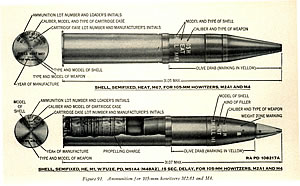
AmmunitionDuring
WWII the authorized howitzer rounds were the M1 high explosive (HE), M67 high
explosive, anti-tank (HE AT), M60 chemical (with "H" mustard gas, "CNS"
tear gas, "WP" white phosphorus smoke, or "FS" smoke loadings),
the M84 base-ejecting HC smoke, the T16 illumination round, and a T18 canister
round. 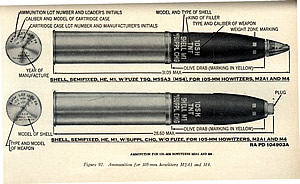 The
M1 and M60 projectiles had the same contour while the M67 HE AT, the M84 base-ejecting
smoke, and T16 illumination projectiles were unique. The T18 canister was apparently
cylindrical. (Information on this round is scant.) The overall lengths varied
because of the different projectiles and different fuzes: The
M1 and M60 projectiles had the same contour while the M67 HE AT, the M84 base-ejecting
smoke, and T16 illumination projectiles were unique. The T18 canister was apparently
cylindrical. (Information on this round is scant.) The overall lengths varied
because of the different projectiles and different fuzes:
- M1
HE - 31.09 inches
- M60
Chemical - 31.08 inches
- M67
HE AT - 31.05 inches
- M84
Smoke - 30.49 inches
- T16
Illumination (later M314) - 32.19 inches
- T18
Canister - unknown
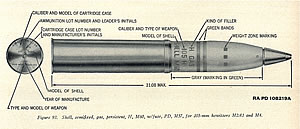 Projectiles
were painted for both identification and camouflage. HE and HE AT projectiles
were yellow with black markings until January 1943, when they became olive drab
with yellow markings. Chemical rounds (including Smoke and Illumination) had a
gray body with colored identification markings: Two green bands for H, two Projectiles
were painted for both identification and camouflage. HE and HE AT projectiles
were yellow with black markings until January 1943, when they became olive drab
with yellow markings. Chemical rounds (including Smoke and Illumination) had a
gray body with colored identification markings: Two green bands for H, two 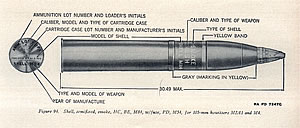 red
bands for CNS, one yellow band for smoke, and one white band for illumination.
For all chemical rounds the lettering color was the same as the band. The T18
projectile was probably black with white markings, like other canister rounds. red
bands for CNS, one yellow band for smoke, and one white band for illumination.
For all chemical rounds the lettering color was the same as the band. The T18
projectile was probably black with white markings, like other canister rounds.
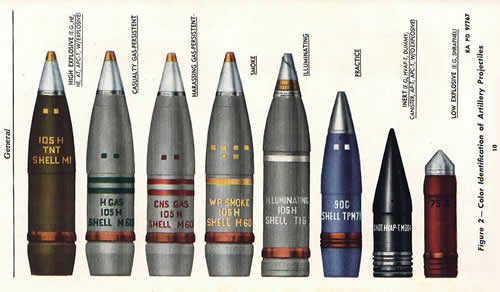
In
addition to color coding projectiles were painted with identifying words and designators
that were meant to be rather obvious, as well as one that wasn't. It isn't possible
to manufacture projectiles within the narrow weight limits required for accurate
fire, so rounds were weighed and grouped into weight zones. The zone was indicated
by a series of small squares on the shell nose. One square would indicate a light
shell, two a shell of standard weight, three or more a heavy one. A crew would
try to segregate their shells by weight so that the firing parameters would not
need to be changed during a fire mission. Only the M1 HE and M60 chemical shells
used weight zone markings. AMMUNITION | MARKING | COLORS | |
M1 HE | 105
H
TNT
SHELL M1 | Yellow
on OD | M1
HE
with deep cavity
for VT fuzes and supplemental charge | 105
H
TNT
SHELL M1
W/SUPPL CHG | Yellow
on OD | | M60
FS smoke | FS
SMOKE
105 H
SHELL M60 | Yellow
on gray | | M60
WP smoke | WP
SMOKE
105 H
SHELL M60 | Yellow
on gray | | M60
H mustard gas | H
GAS
105 H
SHELL M60 | Green
on gray | | M60
CNS tear gas | CNS
GAS
105 H
SHELL M60 | Red
on gray | | M67
HE anti-tank | 105
H
HEAT
SHELL M67 | Yellow
on OD | | M84
HC smoke | HC
SMOKE
105 H
SHELL M84 | Yellow
on gray | | T16
illumination | ILLUMINATING
105
H
SHELL T16 | White
on gray | | T18
canister | 105
H
CANISTER T18
(speculative) | White
on black |
The
same M14 cartridge case dimensions were used for all rounds. The cases were 14.64
inches long and were essentially 4-3/16 inch diameter cylinders with a 4.70 diameter
base flange. Steel cases were used for a time as a material conservation measure
but brass cases were far more common. 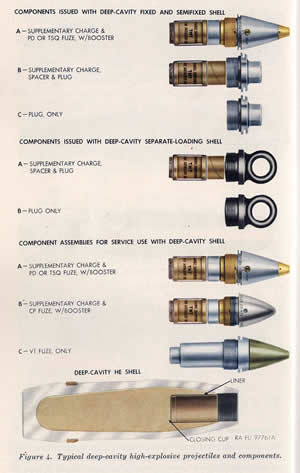 A
number of fuzes were used with 105mm ammunition and most rounds were shipped with
the fuzes installed and made safe with a wire bail through the firing mechanism.
High explosive projectiles used point detonating (PD) or time and super-quick
(TSQ) fuzes. The proximity or VT fuze became available in the fall of 1944, but
its long length required special deep cavity shells. These could not be used with
standard length fuzes so a "supplemental charge" filled the cavity for
normal fuzes but could be removed for the installation of VT fuzes. At the end
of the war a hardened steel tip concrete-piercing (CP) fuze was developed to allow
projectiles to penetrate hard materials before exploding. Neither the VT nor CP
fuzes were issued with complete rounds. Instead they replaced the issued fuze
or were installed in unfuzed projectiles in the field. A
number of fuzes were used with 105mm ammunition and most rounds were shipped with
the fuzes installed and made safe with a wire bail through the firing mechanism.
High explosive projectiles used point detonating (PD) or time and super-quick
(TSQ) fuzes. The proximity or VT fuze became available in the fall of 1944, but
its long length required special deep cavity shells. These could not be used with
standard length fuzes so a "supplemental charge" filled the cavity for
normal fuzes but could be removed for the installation of VT fuzes. At the end
of the war a hardened steel tip concrete-piercing (CP) fuze was developed to allow
projectiles to penetrate hard materials before exploding. Neither the VT nor CP
fuzes were issued with complete rounds. Instead they replaced the issued fuze
or were installed in unfuzed projectiles in the field.
Chemical
rounds normally used PD fuzes while the base-ejecting and illumination rounds
used TSQ types. Fuzes
were typically a mixture of brass and aluminum sections and were colored various
metallic shades.
Overview
Ammunition
Fiber
Containers
Cloverleaf Bundles
Boxes
and Markings
Metal Container
Common
Rounds for Modelers
References
105mm
Howitzer Ordnance: Comparison Review of 1/35 Scale Sets
105mm
Howitzer Kits, Accessories, and Conversions | 

















